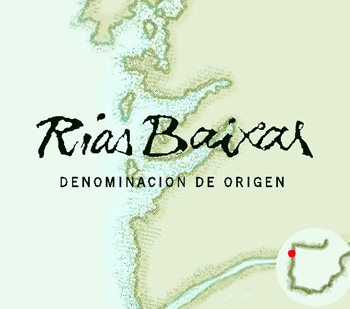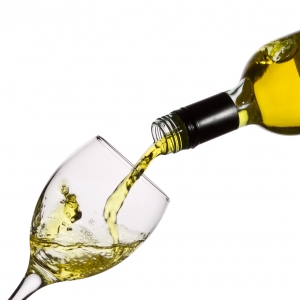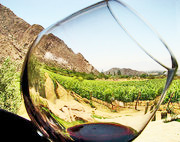Designation of origin Rias Baixas

As in most wine making areas in Spain, in Galicia vines were introduced by the Phoenicians. Around the 2nd century b.C., wine making wasn't too popular in this area and the tribes that lived here (Galician, Asturian, Cantabrian and Basques) drank a kind of beer, and the wine they mention most probably came from trading.
The History of Rias Baixas
The Romans finished the conquest of Galicia (it was then called Gallaecia) around the 19th century b.C. They implanted the vine culture in the area and the produced wine was sent to the troops that had camps in Spain and all over Europe. The vines remained untouched by the Muslims that arrived after the downfall of the Roman Empire. By this time, Galicia had already assimilated the wine culture. The Monks that came by pilgrimage during the Middle Ages and who established their monasteries here brought new vines and new wine making techniques which the locals quickly adapted to their benefits.

During the 16th and 17th century there's a great growth in the wine making business, and this came with the development of new techniques and an improvement in the quality of the wines. In the 19th century, the industrial revolution brought new machinery to ease the production of wine; the invention of the railway helped with the transport of the product and made it easier to reach other trading markets further away; and the profitability of wine meant that many farmers tore up their cereal plantations to plant vines. During some time, the wine making sector was the richest in all of Spain. However, the 19th century also brought a deep economic depression to Galicia, which resulted in a depopulation of the area, and the vines were left to tend to themselves of torn up to plant more profitable crops.
The vineyards didn't recover until the 80s, after the I and II World Wars and the Spanish Civil War were done. They were replanted with Spanish classes of grape, which were more resistant, and the wine sector started picking up. Galicia was also highly benefited when Spain joined the EU and received funding which helped restore the vineyards in the area.
DO Rias Baixas
DO Rias Baixas was established in 1984. Its main activity is the production of white wines with the Albariño grape. It's believed that the Albariño grape was brought to Spain by the Cistercian monks of the Monastery of Armenteira during the 12th century. DO Rias Baixas is located in the southwest of the Pontevedra province, and the area takes the name from the 5 rías (flooded river valleys) that form estuaries along the coast. The 5 rías are Ría de Concubión, Ría de Muros e Noia, Ría de Arousa, Ría de Pontevedra and Ría de Vigo. The famous legend in Spanish culture says that the Rías were formed when God was done creating the world and he placed his hand in Galicia to rest; his fingers dug into the ground and the Rías were formed.

The production area in DO Rias Baixas is divided in 5 sub zones: Val do Salnés, Condado do Tea, El Rosal, Sotomayor and Ribera del Ulla. All of these have similar climatic conditions, mainly Atlantic with mild temperatures and quite a lot of rainfall. The grapes used are Albariño, Loureira Blanca, Treixadura, Caiño blanco, Torrontés and Godello in whites and Caiño tinto, Sousón, Espadeiro, Loureira tinta, Brancellao, Mencia and Pedral in reds.
The alcohol content and characteristics in the wines of Rias Baixas is:
- Rías Baixas Albariño: Produced with 100% Albariño grape. Minimum alcohol content of 11.3%
- Rías Baixas Condado de Tea: Produced with Albariño and Treixadura in 70%. Minimum alcohol content of 11%
- Rías Baixas Rosal: Produced with at least 70% of Albariño and Loureira. Minimum alcohol content of 11%
- Rías Baixas Val do Salnés: Produced with at least 70% of Albariño. Minimum alcohol content of 11%
- Rías Baixas Ribeira do Ulla: Produced with at least 70% of Albariño. Minimum alcohol content of 11%
- Rías Baixas Barrica: Any kind of Rías Baixas wine that has aged for at least 3 months in an oak cask. Minimum alcohol content of 11.5%
- Rías Baixas: Produced with any of the accepted white varieties. Minimum alcohol content of 11.3%
- Rías Baixas Tintos: Produced with any of the accepted red varieties. Minimum alcohol content of 10%
- Rías Baixas Espumosos: Produced with any of the accepted grape varieties. Minimum alcohol content of 11.3%
Spanish Wine History
Spanish Wine Regions and DO
Spanish Wine Tours
Top Spanish designations of origin
Best Spanish Wines
Spanish Wine Production
Spanish Wine Types
Spanish Grapes
Spanish Sparkling Wine: Cava
Sherry Wine
Spanish Wine Cocktails
Spanish Wines in the World
Spanish Wine Prizes
Enotourism
Spanish spirits and liquors
Argentina Wines
Chilean Wines
Other sites